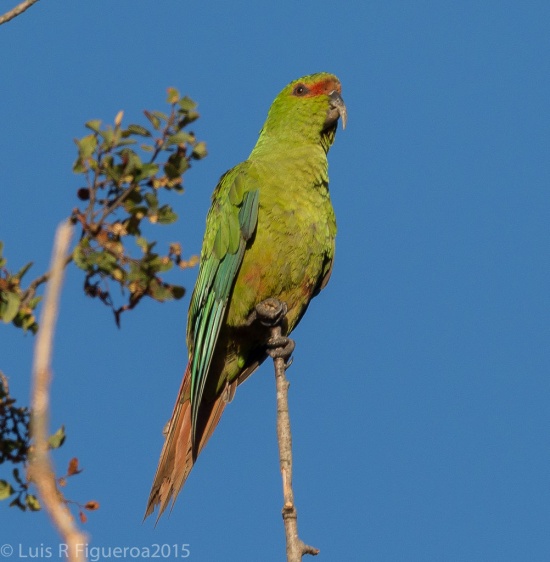(behav, refs, taxon) |
(First image added. References updated) |
||
| (2 intermediate revisions by 2 users not shown) | |||
| Line 1: | Line 1: | ||
| + | [[Image:Choroy.jpg|thumb|550px|right|Photo © by {{user|Luis+R|Luis R}}<br />Cayucupil, Cañete, VIII Region, [[Chile]], 25 January 2015]] | ||
;[[: Category:Enicognathus|Enicognathus]] leptorhynchus | ;[[: Category:Enicognathus|Enicognathus]] leptorhynchus | ||
| Line 8: | Line 9: | ||
[[Chile]] from south of Santiago to Chiloé Island. | [[Chile]] from south of Santiago to Chiloé Island. | ||
==Taxonomy== | ==Taxonomy== | ||
| − | This is a [[Dictionary_M- | + | This is a [[Dictionary_M-O#M|monotypic]] species<sup>[[#References|1]]</sup>. |
| + | |||
==Habitat== | ==Habitat== | ||
Forests. In winter it can be seen on farmland. | Forests. In winter it can be seen on farmland. | ||
| Line 14: | Line 16: | ||
The diet includes seeds and buds of trees. | The diet includes seeds and buds of trees. | ||
| − | In mid summer, it nests in holes high in tall trees, often ''Notophagus''. 6 to 10 white eggs per nest will after about 30 days yield around 4-5 nestlings which stay in the nest for about 40 days. During that period, the nestlings change from a thin white down at hatching to a thicker grey down, to being feathered. The nestlings continue development after leaving the nest. | + | In mid summer, it nests in holes high in tall trees, often ''Notophagus''. 3 to 6 (to 10 -- but maybe two females involved?) white eggs per nest will after about 30 days yield around 4-5 nestlings which stay in the nest for about 40 days. During that period, the nestlings change from a thin white down at hatching to a thicker grey down, to being feathered. The nestlings continue development after leaving the nest. |
==References== | ==References== | ||
| − | #{{Ref- | + | #{{Ref-Clements6thAug19}}# Alvaro Jaramillo. 2003. Birds of Chile. Princeton Field Guides. ISBN 0-691-11740-3 |
#Peña-Foxon et al. Ornitologia Neotropical 22:103-110, 2011 | #Peña-Foxon et al. Ornitologia Neotropical 22:103-110, 2011 | ||
==External Links== | ==External Links== | ||
| Line 22: | Line 24: | ||
| − | [[Category:Birds]][[Category:Enicognathus | + | [[Category:Birds]][[Category:Enicognathus]] |
Latest revision as of 12:34, 22 December 2019
- Enicognathus leptorhynchus
Identification
16 - 16 1/2 in. Green to dark green body. Crown with black transversal lines. Reddish tone in the front and lores. Naked ring surrounding the eyes. Belly with reddish tone few conspicuous. Primaries with bluish inner webs. Dark red tail with greenish tip. Dark grey bill, with hookish and long culmen. Pale pink legs. Long and finely tipped mandible and has a large red forehead patch.
Similar species
Similar to Austral Parakeet, but differs in less red underside with less conspicuous scaling and much longer upper mandible.
Distribution
Chile from south of Santiago to Chiloé Island.
Taxonomy
Habitat
Forests. In winter it can be seen on farmland.
Behaviour
The diet includes seeds and buds of trees.
In mid summer, it nests in holes high in tall trees, often Notophagus. 3 to 6 (to 10 -- but maybe two females involved?) white eggs per nest will after about 30 days yield around 4-5 nestlings which stay in the nest for about 40 days. During that period, the nestlings change from a thin white down at hatching to a thicker grey down, to being feathered. The nestlings continue development after leaving the nest.
References
- Clements, J. F., T. S. Schulenberg, M. J. Iliff, S. M. Billerman, T. A. Fredericks, B. L. Sullivan, and C. L. Wood. 2019. The eBird/Clements Checklist of Birds of the World: v2019. Downloaded from http://www.birds.cornell.edu/clementschecklist/download/
- Alvaro Jaramillo. 2003. Birds of Chile. Princeton Field Guides. ISBN 0-691-11740-3
- Peña-Foxon et al. Ornitologia Neotropical 22:103-110, 2011




